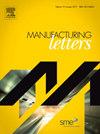Effect of laser beam incident angle on welding of Ti6Al4V with fiber lasers
IF 1.9
Q3 ENGINEERING, MANUFACTURING
引用次数: 0
Abstract
Laser beam welding (LBW) is widely used for welding Ti6Al4V alloys in aerospace applications. LBW has localized high-energy fluence with low-energy input compared to other fusion welding processes, resulting in narrower heat-affected zones. On the other hand, most metals are highly reflective when the laser beam impinges perpendicular to the surface, making the process inefficient. Hence, this work proposes to employ shallow angle incidence to reduce the reflectivity during the welding of Ti6Al4V material. To explore the potential of this idea, the current study focuses on studying the effect of laser incident angle (15°-90°), power (300 W-1500 W), and feed rate (10 mm/s-25 mm/s) on autogenous weld bead geometry. For this purpose, bead-on plate (BOP) LBW is conducted on mill-annealed Ti6Al4V material of dimensions 25 mm × 25 mm × 3 mm by employing a fiber laser source with a maximum power of 3 kW and a wavelength of 1080 nm. It is observed from the results that at a normal incident angle and low laser power (< 600 W), the penetration depth is too low to generate a weld bead. Analyzing the cross-section of the weld bead, obtained from SEM, perpendicular to the weld direction reveals that the increase in laser incident angle up to an optimal angle resulted in increased bead dimensions (width and height), and beyond that, the dimensions decreased. However, the optimal incident angle changed when the laser power was changed. The major finding of this study is that at 600 W and a normal incident angle, the laser could not penetrate and generate a weld bead due to low absorptivity, while at an incident angle of 300, 450, and 600, weld beads are generated because of increased absorptivity. Similarly, the increase in weld dimensions with the increase in laser power is observed. At higher laser power, underfill and oxide formation are observed. The feed rate is less predominant than the incident angle and the power.
激光束入射角对使用光纤激光器焊接 Ti6Al4V 的影响
激光束焊接(LBW)广泛应用于航空航天领域的 Ti6Al4V 合金焊接。与其他熔化焊接工艺相比,激光束焊接具有局部高能通量和低能量输入的特点,因此热影响区更窄。另一方面,当激光束垂直于金属表面时,大多数金属都具有很强的反射性,从而使焊接过程效率低下。因此,这项工作建议在焊接 Ti6Al4V 材料时采用浅角入射来降低反射率。为了探索这一想法的潜力,目前的研究侧重于研究激光入射角(15°-90°)、功率(300 W-1500 W)和进给速度(10 mm/s-25 mm/s)对自生焊珠几何形状的影响。为此,采用最大功率为 3 kW、波长为 1080 nm 的光纤激光源,在尺寸为 25 mm × 25 mm × 3 mm 的轧制退火 Ti6Al4V 材料上进行了焊珠在板上 (BOP) 低温焊接。从结果中可以看出,在正常入射角和低激光功率(< 600 W)条件下,穿透深度太低,无法产生焊珠。通过扫描电子显微镜(SEM)获得的垂直于焊接方向的焊缝横截面分析表明,激光入射角增加到最佳角度时,焊缝尺寸(宽度和高度)增加,超过最佳角度后,焊缝尺寸减小。然而,当激光功率改变时,最佳入射角也随之改变。这项研究的主要发现是,在 600 W 和正常入射角时,由于吸收率低,激光无法穿透并产生焊珠,而在 300、450 和 600 入射角时,由于吸收率增加,焊珠得以产生。同样,随着激光功率的增加,焊缝尺寸也会增加。在较高的激光功率下,会出现填充不足和氧化物形成。与入射角和功率相比,进给速度的影响较小。
本文章由计算机程序翻译,如有差异,请以英文原文为准。
求助全文
约1分钟内获得全文
求助全文
来源期刊

Manufacturing Letters
Engineering-Industrial and Manufacturing Engineering
CiteScore
4.20
自引率
5.10%
发文量
192
审稿时长
60 days
 求助内容:
求助内容: 应助结果提醒方式:
应助结果提醒方式:


